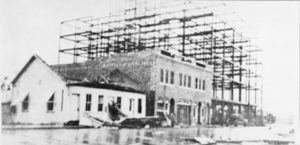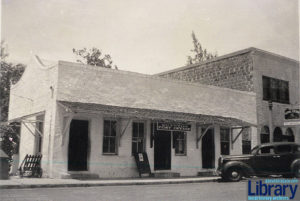Transportation advances opened South Florida to settlers in the 1890s. Before then, only the few pioneer families who took advantage of the 1862 Florida Homestead Act, indigenous tribe members, and African Americans were living in today’s Palm Beach County.
Those demographics changed with the advent of Henry Flagler’s Florida East Coast Railway. Whistlestops and railroad stations popped up along the route. Before the tracks extended through to Boynton in 1896, mail was brought down the Florida East Coast Canal from the Hypoluxo post office located in Hannibal Pierce’s store at the end of the Porter’s Dock by early settlers F.S. Dewey, U.D. Hendrickson, M.B. Lyman, C.W. Pierce, and F.C. Voss.
Boynton’s first official United States post office opened in April 1896 in Lyman’s store on Ocean Avenue with William H. Cox as the first postmaster. Cox filed the Boynton Post Office paperwork on January 31, 1896. In his application he stated that the nearest post offices were Hypoluxo and Lantana (three and four miles north) and Linton (five miles due south). He noted the
Florida East Coast Canal ¼ mile east, and that the Boynton post office would be located 100 yards east of the new FEC railway station.
The train stop was called Boynton after civil war major Nathan Boynton who had plans to build a resort hotel. At this time, mail chiefly consisted of letters, penny postcards, newspapers, magazines, catalogs, seeds, packages, home furnishings and even livestock delivered to the station. Post offices sold money orders, stamps, postcards, and envelopes. Since the Boynton settlers were cut off from most of the world and were hungry for news from their families and hometowns, mail delivery was important to rural life. 
Several Boyntonites held the postmaster title over the next decade including H.B. Murray, J.P. Harper, and C.W. Pierce. Pierce, a former Star Mail Route (aka barefoot) carrier served in this capacity the longest. He was postmaster from 1901 to 1903 and notably from 1908 until his death in 1939 when his wife, assistant postmaster Ethel Sims Pierce assumed the position.
In 1911, Charlie Pierce managed the first stand-alone post office on Ocean Avenue. The wooden structure, reportedly constructed with lumber from the 1909 Coquimbo shipwreck, served as a community focal point. Pierce curated the settlement’s first lending library with select titles sent down from the state library supplemented with titles from his own collection and books donated by Byrd Spilman Dewey as well as those left behind by Boynton Hotel guests.
The 1920s Florida land boom transformed the remote Boynton farming community into a bustling town. Developers purchased land and platted luxurious subdivisions like Boynton Hills and Lake Boynton Estates. A cut was made through the barrier islands connecting the inland canal with the Atlantic Ocean. The George Harvey company started work on the fashionable 12-story Hotel Cassandra on Ocean Avenue. By 1926 the tiny post office was overrun with customers purchasing money orders and sending and receiving items. Postmaster Pierce reported that receipts for the first quarter surpassed the second half of the previous year. The gigantic land bubble began to deflate in 1927 after two powerful hurricanes hit South Florida causing infrastructure damage and delaying shipments. Food and basic supply shipments took priority over construction materials.
In May 1928 a new post office opened next to the old wooden post office. Pierce’s official government report indicated that the new building was located 365 feet east of the Florida East Coast Railway. A deadly September 1928 hurricane slammed Palm Beach County damaging and destroying many Boynton buildings and claiming several thousand lives in western Palm Beach County. The grandiose building plans for Boynton halted. Skeletons of buildings and ghost developments haunted the once vibrant town. The Bank of Boynton closed its doors in 1929, and many people left town to avoid paying taxes and to pursue other opportunities.
The Town of Boynton incorporated as the City of Boynton Beach in 1941 with postmaster Ethel Pierce filing the post office name change. In 1946 receipts exceeded $10,000 making Boynton eligible for a new post office building.
The post office moved to the Puritin Building (also on Ocean) in 1949. Mail delivery began in 1956 after Mrs. Pierce convinced town officials to number all residences and businesses. Mail carriers rode bicycles or drove cars on their routes. Mrs. Pierce retired after this big change, with Richard Monahan succeeding her long tenure.
A modern, air-conditioned fire-proof post office at the corner of Seacrest and Boynton Beach Blvd. opened in 1963. The large new facility had automatic lights, improved mail processing capacity and 17 off-street parking spots for customers, with a separate parking lot for employees. It had vending machines for dispensing stamps and self-service post office box rentals. This post office has served as the downtown post office for six decades, and the familiar building still looks much the same as it did when it was new.
Photographs courtesy of the Boynton Beach City Library Local History Archives









